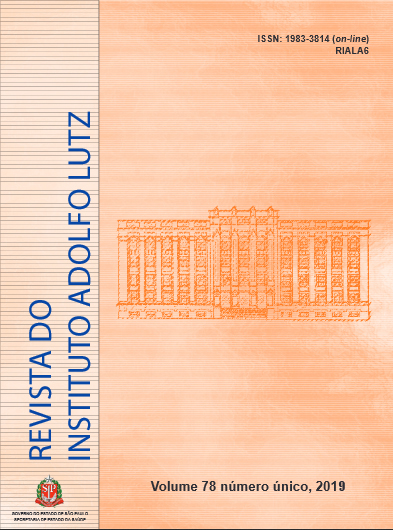Abstract
NASA’s Earth Observing Satellites (EOS) were used to calculate three vegetation indices, extract precipitation and elevation data, and then evaluate their applicability for assessing risk of visceral leishmaniasis (VL) and cutaneous leishmaniasis (CL) in Bahia State, Brazil. Regression models showed that either form of leishmaniasis can be predicted by NDVI, NDMI, NDWI data products and TRMM) precipitation data (R2= 0.370; p<0.001). Elevation was not significantly associated with the distribution of either VL or CL. In areas of high annual precipitation, CL was 3.6 times more likely to occur than VL. For vegetative moisture (NDMI), CL was 2.11 times more likely to occur than VL. Odds of CL occurrence increased to 5.5 times when vegetation (NDVI) and 13.5 times when liquid water content of vegetation canopies (NDWI) was considered. Areas at risk of CL and VL were mapped based on the selected explanatory variables. Accuracy of models were assessed using area under the receiver operating characteristic curve (AUC=0.72). We propose that statewide scale risk models based on use of EOS products will be a useful tool at 1 km2 spatial resolution to enable health workers to identify and target high risk areas to prevent transmission of leishmaniasis
References
1. Valderrama-Ardila C, Alexander N, Ferro C, Cadena H, Marín D, Holford TR et al. Environmental risk factors for the incidence of American cutaneous leishmaniasis in a sub-andean zone of Colombia (Chaparral, Tolima). Am J Trop Med Hyg. 2010;82(2):243–50. http://dx.doi.org/10.4269/ajtmh.2010.09-0218
2. Bhunia GS, Kesari S, Jeyaram A, Kumar V, Das P. Influence of topography on the endemicity of Kala-azar: a study based on remote sensing and geographical information system. Geospat Health. 2010;4(2):155–65. http://dx.doi.org/10.4081/gh.2010.197
3. Bavia ME, Carneiro DDMT, Gurgel HC, Madureira Filho C, Barbosa MGR. Remote sensing and geographic information systems and risk of American Visceral Leishmaniasis in Bahia , Brazil. Parasitologia. 2005;47(1):165–9.
4. Instituto Brasileiro de Geografia e Estatística - IBGE. Estudos e pesquisas: informação demográfica e socioeconômica, 28. Indicadores sociais municipais: uma análise dos resultados do universo do censo demográfico 2010. Rio de Janeiro(RJ): IBGE; 2011. Avaliable in: https://biblioteca.ibge.gov.br/visualizacao/livros/liv54598.pdf
5. Gu Y, Hunt E, Wardlow B, Basara JB, Brown JF, Verdin JP. Evaluation of MODIS NDVI and NDWI for vegetation drought monitoring using Oklahoma Mesonet soil moisture data. Geophys Res Lett. 2008;35(22). http://dx.doi.org/10.1029/2008GL035772
6. Hayes D, Cohen W, Sader S, Irwin D. Estimating proportional change in forest cover as a continous variable from multi-layer MODIS data. Remote Sens Environ. 2008;112:735–49. http://dx.doi.org/10.1016/j.rse.2007.06.003
7. Elith JH, Graham CP, Anderson R, Dudík M, Ferrier S, Guisan A et al. Novel methods improve prediction of species’ distributions from occurrence data. Ecography. 2006;29(2):129–51. http://doi.wiley.com/10.1111/j.2006.0906-7590.04596.x
8. Jin S, Sader SA. Comparison of time series tasseled cap wetness and the normalized difference moisture index in detecting forest disturbances. Remote Sens Environ. 2005;94(3):364–72. https://doi.org/10.1016/j.rse.2004.10.012
9. Gao BC. NDWI - A normalized difference water index for remote sensing of vegetation liquid water from space. Remote Sens Environ. 1996;58(3):257–66. Avaliable in: http://ceeserver.cee.cornell.edu/wdp2/cee6150/Readings/Gao_1996_RSE_58_257-266_NDWI.pdf
10. Franke CR, Staubach C, Ziller M, Schlüter H. Trends in the temporal and spatial distribution of visceral and cutaneous leishmaniasis in the state of Bahia, Brazil, from 1985 to 1999. Trans R Soc Trop Med Hyg. 2002;96(3):236–41. http://dx.doi.org/10.1016/s0035-9203(02)90087-8"
11. Bavia ME, Hale LF, Malone JB, Braud DH, Shane SM. Geographic information systems and the environmental risk of schistosomiasis in Bahia, Brazil. Am J Trop Med Hyg. 1999;60(4):566–72. http://dx.doi.org/10.4269/ajtmh.1999.60.566”
12. Bhunia GS, Kesari S, Chatterjee N, Pal DK, Kumar V, Ranjan A et al. Incidence of visceral leishmaniasis in the Vaishali district of Bihar, India: spatial patterns and role of inland water bodies. Geospat Health. 2011;5(2):205–15. http://dx.doi.org/10.4081/gh.2011.173
13. Saraiva L, Andrade Filho JD, Falcão AL, de Carvalho DA, de Souza CM, Freitas CR et al. Phlebotominae fauna (Diptera: Psychodidae) in an urban district of Belo Horizonte, Brazil, endemic for visceral leishmaniasis: characterization of favored locations as determined by spatial analysis. Acta Trop. 2011;117(2):137–45. http://dx.doi.org/10.1016/j.actatropica.2010.11.007
14. Cerbino Neto J, Werneck GL, Costa CH. Factors associated with the incidence of urban visceral leishmaniasis: an ecological study in Teresina, Piauí State, Brazil. Cad Saude Publica . 2009;25(7):1543–51. http://dx.doi.org/10.1590/S0102-311X2009000700012
15. McFeeters SK. Using the normalized difference water index (NDWI) within a geographic information system to detect swimming pools for mosquito abatement: a practical approach. Remote Sens. 2013;5(7):3544–61. https://doi.org/10.3390/rs5073544
16. Wilson EH, Sader SA. Detection of forest harvest type using multiple dates of Landsat TM imagery. Remote Sens Environ. 2002;80:385–96. https://doi.org/10.1016/S0034-4257(01)00318-2
17. Elnaiem DEA, Schorscher J, Bendall A, Obsomer V, Osman ME, Mekkawi AM et al. Risk mapping of visceral leishmaniasis: the role of local variation in rainfall and altitude on the presence and incidence of kala-azar in eastern Sudan. Am J Trop Med Hyg. 2003;68(1):10–7. http://dx.doi.org/10.4269/ajtmh.1999.60.566”

This work is licensed under a Creative Commons Attribution 4.0 International License.
Copyright (c) 2019 Instituto Adolfo Lutz Journal
